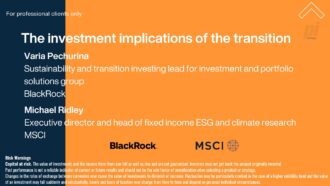Hammersmith and Fulham Pension Fund vice-chairman Michael Adam said some local government funds needed to be educated and in some cases were having trouble convincing the powers-that-be that there is more available to the portfolio than just equities. “We are not capturing any great illiquidity premium,” he added. “Local authorities have an argument to fight.”
M&G co-head of alternative credit William Nicoll said while interest from pension funds was growing, they trailed other institutions in terms of market participation. “It is coming from a low base; pension funds are taking only a small bit,” he added. “The major competitors are still the big insurers and sovereign wealth funds.”
The final session of the morning looked at the various forms of debt available to investors. Delegates heard how the starting point for investing in any form ofalternative credit is to have a clear idea of what you are investing in and what you hope to achieve from it delegates heard during the new opportunities panel.
A brave new world of debt
Cairn Capital chief investment officer Andrew Jackson said one of institutional investors’ “biggest weapons” was the ability to invest in less liquid assets, but warned just because some things seem liquid upfront does not necessarily guarantee they will be if something goes wrong down the line.
“There are myriad risks out there,” he said. “The biggest one for pension funds is not understanding what they are investing in. They need to take a lot of time and energy understanding what they are investing in, what they can do if it goes wrong and what the levers are they can pull when those things occur. That is a massive challenge for pension funds.
“The starting point should maybe be what do I not want to invest in? What risks do I not want to take? We talk a lot about the illiquidity pension funds are prepared to take but assets may appear liquid now, but when the shit hits the fan, will they really be liquid?”
Rogge Global Partners senior partner David Newman said there is a risk of something going wrong in any type of credit strategy, so it is therefore important to be diversified across as many assets as possible – but only if each asset class can be covered properly by a manager.
He warned: “Diversification for diversification’s sake is very dangerous. You can run a portfolio of 250 names and if you don’t know a hundred of them it is more dangerous than having a portfolio of 10 and knowing them all very well.”




Comments